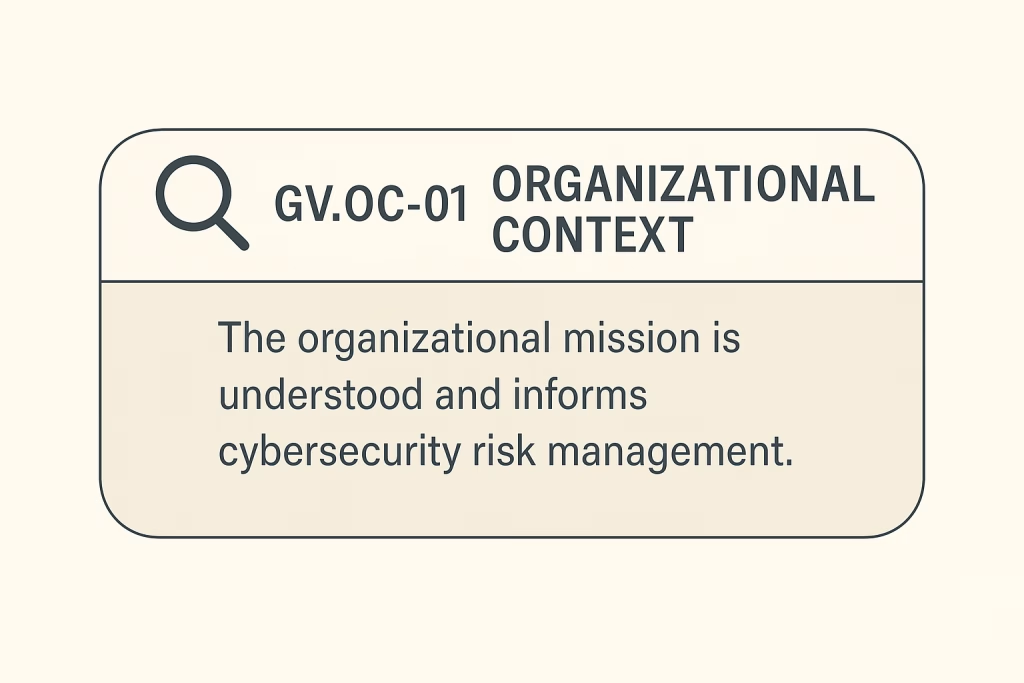Let the Mission Lead: Connecting Purpose to Cybersecurity
In NIST CSF 2.0, the Govern (GV) Function brings cybersecurity into the boardroom. And at the heart of this function lies GV.OC-01, a deceptively simple idea with powerful implications:
“The organizational mission is understood and informs cybersecurity risk management.”
This subcategory challenges organizations to go beyond tech and ask: Does our cybersecurity program support what we’re actually trying to achieve as a business?
This isn’t just about hanging a mission statement in the lobby. It’s about operationalizing purpose, aligning cyber decisions to what the organization is built to do.
Why It Matters
In too many organizations, cybersecurity operates in a silo, disconnected from business goals. GV.OC-01 challenges this status quo by requiring organizations to connect the dots between what the business values most and how cybersecurity supports that mission.
The risks that threaten your mission, whether it’s innovation, customer safety, uptime, or compliance, should drive how you prioritize, invest, and respond.
| Enterprise | Product Security | Information Security – Corporate | Information Technology |
|---|---|---|---|
| - Is the mission used as a reference point for evaluating cyber risks? | - Are security controls embedded into the product lifecycle with respect to brand and mission (e.g., customer trust, innovation)? | - Does the security program incorporate the mission into key policies and frameworks? | - Is the mission influencing infrastructure priorities like availability, segmentation, or SLAs? |
| - How often are cyber goals tied to strategic business objectives? | - Are customer-facing security decisions aligned with core values? | - Are corporate risks mapped to mission-relevant areas (e.g., reputation, compliance)? | - Do IT project decisions consider mission dependencies? |
| - Are cross-functional leaders aligning cyber initiatives to business intent? | - Is threat modeling driven by mission-critical risks? | - Do awareness and internal communications reinforce mission alignment? | - Are SLAs tied back to what’s critical for business delivery? |
| Tier Level | Process Expectation | Description |
|---|---|---|
| Tier 1 – Initial | No standard process | Cyber risk management is reactive, and there is no formal alignment to the organization’s mission. |
| Tier 2 – Developing | Ad hoc, informal processes | Mission is known at executive level but not clearly linked to cybersecurity activities. Risk decisions may reflect mission informally. |
| Tier 3 – Established | Documented process; <10% exceptions | Mission is referenced during cybersecurity planning; certain teams actively map cyber risks to mission objectives. |
| Tier 4 – Advanced | Documented with metrics; <5% exceptions | Organization-wide awareness of how cyber risk management supports mission. Integrated into governance and planning frameworks. |
| Tier 5 – Optimizing | Documented, improving, <1% exceptions | Continuous refinement and optimization of cybersecurity strategy based on changes to business mission, with mission-driven metrics and decision-making at all levels. |
From Good to Great: What Tier 5 Looks Like
A Tier 5 organization doesn’t just mention the mission in its strategy, it uses it to drive decisions across all layers of cybersecurity, from budgeting to incident response to product design.
Example: If your mission includes innovation, you might prioritize secure-by-design practices in R&D, ensure IP protection, and use fast, secure CI/CD pipelines, because those are core to business success.
Closing Thoughts…
GV.OC-01 isn’t just a checkbox, it’s a compass. When cybersecurity is guided by your organization’s mission, you’re not just reducing risk. You’re reinforcing what makes your organization valuable, trusted, and resilient.
